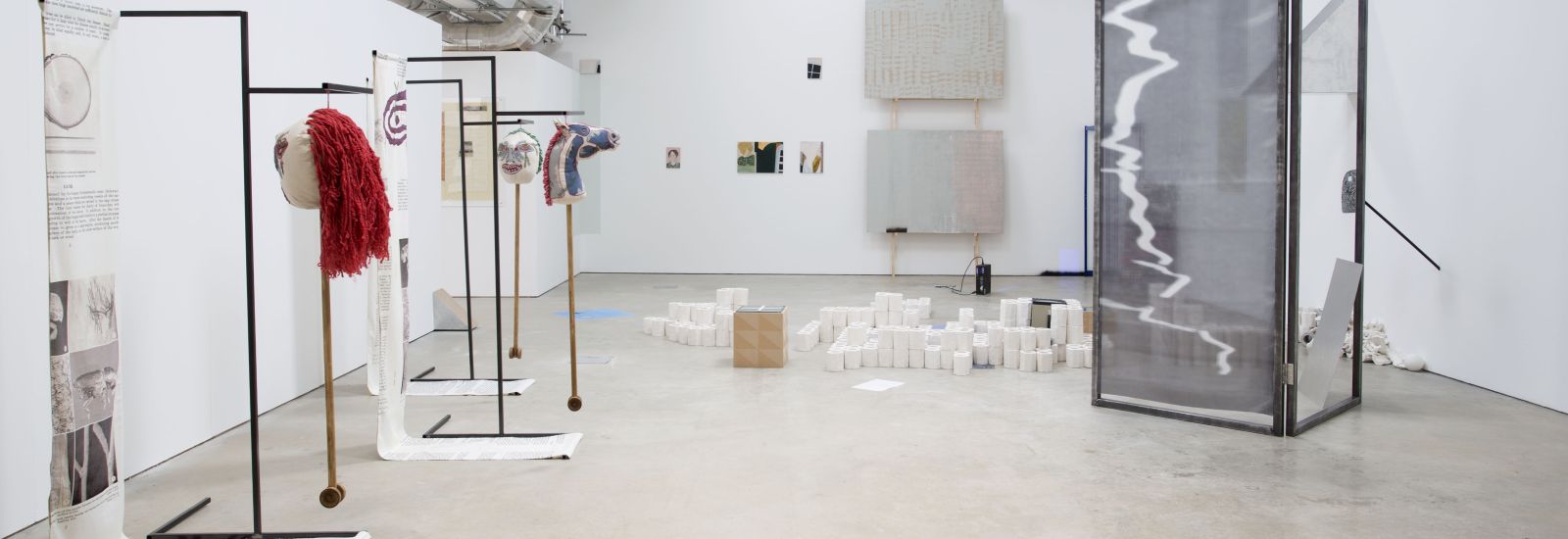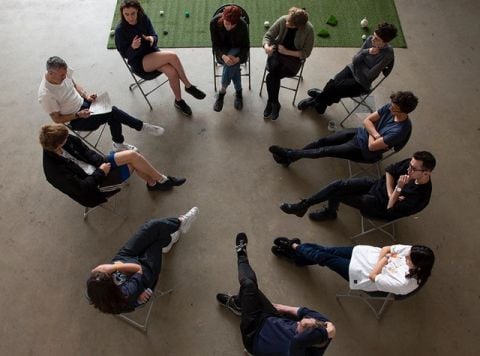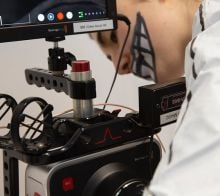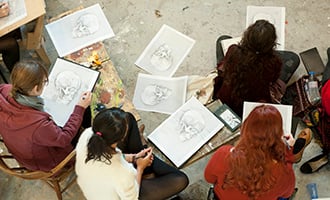
Fine Art
Course overview
UCAS code: W100
Entrance requirements: AAA / AAB (see admissions requirements tab)
Course duration: 3 years (BFA)
Subject requirements
Required subjects: Not applicable
Recommended subjects: Art
Helpful subjects: Not applicable
Other course requirements
Admissions tests: None
Written Work: Digital portfolio (but no written work submission required)
Admissions statistics*
Interviewed: 23%
Successful: 11%
Intake: 28
*3-year average 2022-24
Contact
Tel: +44 (0) 1865 276940
Email: info@rsa.ox.ac.uk
Unistats information for this course can be found at the bottom of the page
Please note that there may be no data available if the number of course participants is very small.
About the course
Fine Art is the making and study of visual art. It educates and prepares students to become artists and to follow other practices that are aligned with the making of art. The curriculum is centred on the individual student’s potential and imagination.
The Ruskin School of Art offers a three-year studio-based BFA course in which students work alongside each other in collaboratively-organised studios. Whereas many fine art courses run in an environment devoted exclusively to art and design, Ruskin students, as members of a collegiate university, have the advantage of contact with their contemporaries on all of Oxford’s other courses.
The Ruskin course aims to develop strong independent points of view and a mature grasp of the range of critical debate surrounding contemporary art and its many international histories. Oxford’s short terms, coupled with the ambitious atmosphere at the Ruskin, suit highly-motivated and resourceful students with a good sense of how to organise their time both in and out of Oxford.
The first year of the course is structured to introduce students to one another, to the resources of the school and to the staff involved in teaching and running the Ruskin. Students will familiarise themselves with their fellow students’ work, take part in group criticism and engage in intensive dialogue with tutors and visiting artists.
The intimate working environment of the school, arranged in two buildings, allows art history, theory and criticism to be treated as integral to the development of studio work. The Ruskin also enjoys a strong and constructive relationship with Modern Art Oxford (an exciting and influential contemporary art space) and other local and London-based arts organisations. Students also have full access to the many exceptional University libraries and museums, including the Ashmolean and the Bodleian Art, Archaeology and Ancient World Library.
 |  |  |
| 'Unlike ... other art courses in the UK, the Ruskin does not require you to specialise in any particular medium. [And] the interesting blend of academic and practical that this course offers was perfect for me.' Holly | 'My time at the Ruskin was extremely positive... The majority of the course is structured for independent practice, but the studio environment means there are always people around to bounce ideas off... The sense of community and support at Ruskin is what makes it stand out, and the course will help nurture your practice in a caring and challenging way.' Jessica |
Unistats information
Discover Uni course data provides applicants with Unistats statistics about undergraduate life at Oxford for a particular undergraduate course.
Please select 'see course data' to view the full Unistats data for Fine Art.
Please note that there may be no data available if the number of course participants is very small.
Fine Art
A typical week
A week will typically consist of several of the following:
- a one-to-one studio-based tutorial focusing on the individual student’s art work
- a tutor-led group critique or other bespoke teaching session
- a skills-based workshop
- a history and theory lecture and/or seminar or essay tutorial
- a talk by a visiting speaker.
Students spend much of their time working in their own studio spaces, where they are supported by specialists in the art-making techniques available at the Ruskin.
Tutorials are usually one-to-one with a tutor. Typically there are 6-12 students in a group critique (in which students present their work, and discussion is guided by one or two tutors). There are usually no more than 12 students in any workshop or seminar, around 30 for lectures, and 90 for the all-school visiting speakers’ talks.
Teaching is delivered by staff who are dedicated tutors in their subject. Many are leading artists and writers with years of experience in teaching and research. Some teaching may be delivered by postgraduate students who are studying at doctoral level.
To find out more about how our teaching year is structured, visit our Academic Year page.
Course structure
Year 1
Courses | Assessment |
|---|---|
Students develop their studio work in discussion with the school’s faculty, tutors and visiting staff. They are allocated a studio tutor each term, who monitors progress, sets targets and directs them in their studies. Work is regularly presented and discussed at group critiques involving staff and students from across the school. Alongside this, workshops and projects are offered throughout the year to introduce a range of techniques and approaches to the making and curating of artwork. In addition, students attend weekly anatomy classes (including visits to the Anatomy Suite at the Medical Sciences Teaching Centre), in which they explore, and produce work relating to, the human body. | Submission of portfolios of studio-based work, including human anatomy, and an exhibition; three submitted essays in the history and theory of visual culture. |
Years 2 and 3
Courses | Assessment |
|---|---|
Years two and three are similar in structure to the first year (except for Anatomy, which is taught only in the first year), and continue the tutorial and group crit system introduced in the first year. All students are required to continue the study of art history and theory and to submit three essays during the second year. In their third year, Finalists choose a subject for, and research and write, with supervision from a specialist tutor, an extended, 6,000-word essay which is submitted at the end of the second term as part of the Final Examination. In the lead-up to their final degree show, students are supported with portfolio supervision, and professional practice and exhibition workshops. | Assessment (Year 2) Assessment (Year 3) |
Visit the Fine Art website for more information.
The content and format of this course may change in some circumstances. Read further information about potential course changes.
Academic requirements
Qualification | Requirements |
|---|---|
A-levels: | AAA (or AAB for candidates who have undertaken or completed a post-18 Art Foundation course*) |
Advanced Highers: | AA/AAB |
International Baccalaureate (IB): | 38 (including core points) with 666 at HL |
Applied General Qualifications: | BTEC and Cambridge Technical Extended Diplomas: DDD |
Any other equivalent qualification: | View information on other UK qualifications, and international qualifications. |
* Post A-level applicants with AAB at A-level (or equivalent) will be expected to submit an outstanding portfolio and to achieve at least a Merit or equivalent on their Foundation course.
If applicants are studying for the UAL Level 3 Applied General Extended Diploma in Art and Design they would be expected to achieve a High Merit.
Wherever possible, your grades are considered in the context in which they have been achieved.
Read further information on how we use contextual data.
Subject requirements
Recommended: | The Ruskin recommends that candidates have studied Art at A-level or equivalent qualification. It is highly recommended that candidates have undertaken a post-18 Art Foundation course before applying. |
|---|
If a practical component forms part of any of your science A‐levels used to meet your offer, we expect you to pass it.
If English is not your first language you may also need to meet our English language requirements.
Applying
All candidates must follow the application procedure as shown on our Applying to Oxford pages.
The following information gives specific details for students applying for this course.
Portfolio submission
Description: | Portfolios must be submitted digitally, via an online platform called SlideRoom, which will be made available on the Ruskin website shortly after the application deadline. Candidates who have submitted a UCAS application to study for the BFA programme will be emailed the link to SlideRoom. There is no prescription for the content of a portfolio. Candidates should aim to include a range of work which gives a sense of their artistic and intellectual interests and their curiosity about contemporary art and its concerns. You will be able to upload your portfolio with videos, photographs, audio files and PDFs. Please visit the Ruskin website for further information.* |
|---|---|
Submission deadline: | Thursday 7 November 2025 |
*Read more about the portfolio
Interview
Interviews take place in early December.
What are tutors looking for?
All applicants are required to submit a portfolio of their art work. Tutors are looking for work that goes beyond the mere fulfilment of school curricula.
Tutors will seek evidence of a breadth of engagement, a sense of purpose and an emerging artistic voice in the way the portfolio is edited.
If you are shortlisted you will be asked to submit a small number of additional recent pieces of your work to discuss during interview.
View the Ruskin School of Art website for more detail on the selection criteria for this course.
Careers
After graduation, most students go on to work in the arts sector, as practising artists, teachers, curators, fabricators and technicians, in public and private museums and galleries, community arts organisations and for culture and heritage councils and institutions - recent alumni have taken up educational and curatorial roles in major art institutions such at Tate, the Baltic Gateshead, the Hepworth Wakefield and Modern Art Oxford. Many also pursue careers in architecture, music and theatre, communications, and the film and digital media industries.
Others continue in academia and art writing: Dan Fox (BFA 1998) was for a long time the Chief Editor (New York) of Frieze Magazine, and numerous Ruskin alumni contribute regularly to other leading publications.
Recent graduates have gained scholarships on highly regarded post-graduate programmes including at the Whitney Independent Studies Program, and the Carnegie Mellon School of Art. Ruskin alumni also teach and research in art schools/departments across the country and internationally.
Many Ruskin graduates have won or been shortlisted for prestigious awards and prizes across many media:
- Tom Woolner (BFA 2001, and now a Ruskin Senior Tutor) was nominated for the John Moores Painting Prize 2023.
- Emma D'Arcy (BFA 2015) was nominated for a Golden Globe in 2022.
- In 2019, Nazia Khan (BFA 1990) represented Pakistan at the Venice Biennale.
- The works of Khushna Sulaman-Butt and Alvin Ong (both BFA 2018) were included in the BP Portrait Award at the National Portrait Gallery, London in 2018.
- Nathaniel Mellors (BFA 1999) represented Finland in Venice in 2017.
- In 2016, Helen Marten (BFA 2008) won the Turner Prize and the Hepworth Prize for Sculpture.
- Paul Franklin (BFA 1989) was awarded the Oscar for Visual Effects for his work on the science fiction film Interstellar in 2015.
- Conrad Shawcross (BFA 1999) won the Jack Goldhill Award for Sculpture in 2014.
- Elizabeth Price (BFA 1988) won the Turner Prize in 2012.
Ruskin graduates have been long-listed for the annual Platform Prize, with accompanying solo exhibitions at Modern Art Oxford:
- Sarah Catterall, 2023
- Eliza Owen, 2022
- Beth Simcott, 2021
- Mihaela Man, and James Scott, 2020
- Grace Robertson 2019
- Luke Dawes - shortlisted, 2018
- Nathan Caldecott – shortlisted 2017.
Ruskin Alumni have regularly been included in Bloomberg New Contemporaries, and the 5-yearly British Art Show.
Note: These annual fees are for full-time students who begin this undergraduate course here in 2025. Course fee information for courses starting in 2026 will be updated in September.
We don't want anyone who has the academic ability to get a place to study here to be held back by their financial circumstances. To meet that aim, Oxford offers one of the most generous financial support packages available for UK students and this may be supplemented by support from your college.
Fees
Fee status | Annual Course fees |
| Home | £9,535 |
| Overseas | £41,130 |
Further details about fee status eligibility can be found on the fee status webpage.
For more information please refer to our course fees page. Fees will usually increase annually. For details, please see our guidance on likely increases to fees and charges.
Living costs
Living costs at Oxford might be less than you’d expect, as our world-class resources and college provision can help keep costs down.
Living costs for the academic year starting in 2025 are estimated to be between £1,425 and £2,035 for each month you are in Oxford. Our academic year is made up of three eight-week terms, so you would not usually need to be in Oxford for much more than six months of the year but may wish to budget over a nine-month period to ensure you also have sufficient funds during the holidays to meet essential costs. For further details please visit our living costs webpage.
Financial support
Home | A tuition fee loan is available from the UK government to cover course fees in full for Home (UK, Irish nationals and other eligible students with UK citizens' rights - see below*) students undertaking their first undergraduate degree**, so you don’t need to pay your course fees up front. In 2025 Oxford is offering one of the most generous bursary packages of any UK university to Home students with a family income of around £50,000 or less, with additional opportunities available to UK students from households with incomes of £32,500 or less. The UK government also provides living costs support to Home students from the UK and those with settled status who meet the residence requirements. *For courses starting on or after 1 August 2021, the UK government has confirmed that EU, other EEA, and Swiss Nationals will be eligible for student finance from the UK government if they have UK citizens’ rights (i.e. if they have pre-settled or settled status, or if they are an Irish citizen covered by the Common Travel Area arrangement). The support you can access from the government will depend on your residency status. |
Islands | Islands students are entitled to different support to that of students from the rest of the UK. Please refer the links below for information on the support to you available from your funding agency: |
Overseas | Please refer to the "Other Scholarships" section of our Oxford Bursaries and Scholarships page. |
**If you have studied at undergraduate level before and completed your course, you will be classed as an Equivalent or Lower Qualification student (ELQ) and won’t be eligible to receive government or Oxford funding
Additional Fees and Charges Information for Fine Art
In the first year of the BFA course, students are provided with basic materials and more specialist materials are available to buy at cost. There is no expectation for students to arrive with any additional equipment or materials beyond those they may already possess.
Each student receives a materials grant (currently £475) from the Ruskin School of Art for each year of the course. Finalists also receive a further materials grant (£280) for their work in the final show. Students are expected to meet any additional costs for materials, and may apply to their college for support in the first instance. Colleges may also provide support for student projects and travel.
Throughout the course, students are able to borrow an extensive selection of equipment on a sign-up basis.
Final year students normally stage a public exhibition of their work following the final examination and they collectively raise funds for this through sponsorship, art sales and other activities.
Contextual information
Course data from Discover Uni provides applicants with statistics about undergraduate life at Oxford. But there is so much more to an Oxford degree that the numbers can’t convey.
The Oxford tutorial
Tutorials are central to teaching at Oxford. Unlike in other subjects, where tutorials usually take place in a student’s college, all Fine Art teaching takes place within the Ruskin, including tutorials. Each student meets their studio tutor at least four times a term, for a 1:1 discussion of their art practice, and also receives an individual essay tutorial for each piece of submitted coursework. All Fine Art students also have a college tutor, who provides additional support and guidance throughout their studies.
Students will also receive teaching in a variety of other ways. This will include lectures, seminars, and group critiques, and various workshops and visits. However, tutorials offer a level of personalised attention from academic experts unavailable at most universities.
Such regular and rigorous academic discussion develops and facilitates learning in a way that isn’t possible through lectures alone. Tutorials also allow for close progress monitoring so tutors can quickly provide additional support if necessary.
Read more about tutorials and an Oxford education.
College life
Our colleges are at the heart of Oxford’s reputation as one of the best universities in the world.
At Oxford, everyone is a member of a college as well as their subject department(s) and the University. Students therefore have both the benefits of belonging to a large, renowned institution and to a small and friendly community.
Each college or hall is made up of academic and support staff, and students. Colleges provide a safe, supportive environment leaving you free to focus on your studies, enjoy time with friends and make the most of the huge variety of opportunities.
Each college has a unique character, but generally their facilities are similar. Each one, large or small, will have the following essential facilities:
- Porters’ lodge (a staffed entrance and reception)
- Dining hall
- Lending library (often open 24/7 in term time)
- Student accommodation
- Tutors’ teaching rooms
- Chapel and/or music rooms
- Laundry
- Green spaces
- Common room (known as the JCR).
All first year students are offered college accommodation either on the main site of their college or in a nearby college annexe. This means that your neighbours will also be ‘freshers’ and new to life at Oxford. This accommodation is guaranteed, so you don’t need to worry about finding somewhere to live after accepting a place here, all of this is organised for you before you arrive.
All colleges offer at least one further year of accommodation and some offer it for the entire duration of your degree. You may choose to take up the option to live in your college for the whole of your time at Oxford, or you might decide to arrange your own accommodation after your first year – perhaps because you want to live with friends from other colleges.
While college tutors primarily support your development, you can also ask their advice on other things. Lots of other college staff including welfare officers help students settle in and are available to offer guidance on practical or health matters. Current students also actively support students in earlier years, sometimes as part of a college ‘family’ or as peer supporters trained by the University’s Counselling Service.
APPLY
No deferred applications accepted
FIND OUT MORE

Our 2025 undergraduate Open Days will be held on 2 and 3 July and 19 September.
Register to find out more about our upcoming Open Days.
Top-rated art school in the UK
The Complete University Guide placed the Ruskin as the leading art school in the UK in 2023, 2022, 2020, 2019, 2017, 2016 and 2015.
RELATED PAGES
Related courses
Feel inspired?
If would like to read around the subject, the following suggestions are a good place to start:
- Julieta Aranda ed., What is Contemporary Art?
- Eddie Chambers, Black Artists in British Art
- Peter Kalb, Art since 1980
- Roland Barthes, Camera Lucida: Reflections on Photography
- Julian Stallabrass, Contemporary Art: A Very Short Introduction
- Audre Lorde, The Master's Tools Will Never Dismantle the Master's House.
You might like to look at some online resources, such as ArtForum or the repository of moving image and sound art, UBU Web. There are also lots of fascinating journals, including e-flux, Frieze and ArtRabbit.
We recommend prospective students attend exhibitions and look at art works as much as possible.
Public art galleries are excellent places to see contemporary art. For example:
- Tate Modern
- Whitechapel
- the Serpentine in London
- the Ikon in Birmingham
- the Liverpool Tate
- the Whitworth in Manchester
- the Baltic in Gateshead
- the Arnolfini in Bristol
- Tramway in Glasgow.
The Tate Modern website also has links to articles and videos on contemporary art and artists.
